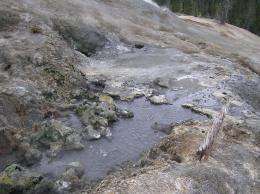New species of archaeon named after ASU professor

A recent manuscript published in The Archives of Microbiology documents the discovery of a hyperthermophilic archaeon in Yellowstone National Park. It is proposed that this archaeon be named in honor of professor Everett L. Shock who pioneered the integrated geochemical and microbiological investigation into Yellowstone National Park hot springs.
Shock is from ASU’s Department of Chemistry and Biochemistry and the School of Earth and Space Exploration in the College of Liberal Arts and Sciences.
Archaea are a group of single-celled microorganisms undiscovered until the 1970s. They comprise a completely separate domain of life from bacteria and eukaryota. Most archaea resemble bacteria when viewed under a microscope, however biochemically and genetically they are as different from bacteria as are humans.
The hot springs of Yellowstone National Park are the first place archaea were discovered. They also live in the anoxic muds of marshes as well as the bottom of the ocean. They even thrive in deep underground petroleum deposits.
Thermogladius shockii has some very interesting features. It lives in temperatures ranging from 64 to 93 C, with an optimum at 84 C (that's 183 F), over a wide range of pH, and unlike its closest relatives, it is indifferent to sulfur compounds.
Yellowstone National Park has the largest surface area of terrestrial hydrothermal activity on Earth. Since 1999, Everett Shock has led field expeditions to Yellowstone with the intent to integrate the geochemistry and microbiology of hot spring ecosystems.
“The success of these trips has depended on the hard work and enthusiasm of graduate students, undergraduates, faculty collaborators and several colleagues from other institutions,” explains Shock.
Shock and co-workers have taken a unified approach to scientific sampling at hot springs by collecting material for geochemical, microbiological, and molecular biological analyses simultaneously from the same locations. Once the field and lab data are collected they can be integrated to give a multidimensional view of how hot spring ecosystems work.
Geochemical samples of water, gases, microbial biofilms, sediment and rock yield compositional data for major and trace elements, organic solutes, trace gases, and mineralogy. These data are used in thermodynamic analyses of the supplies of chemical energy from oxidation-reduction reactions that fuel microbial metabolism. The resulting theoretical predictions supply a framework for interpreting isotopic compositions, phylogenetic data and environmental genomic results from co-located biological samples, and guide the search for specific genes.
In turn, new interpretations of molecular biology data are facilitated by the comprehensive sets of geochemical data. This combination of approaches yields novel insights into the structure and function of high-temperature microbial communities, and new ideas about how those communities participate in the geochemical processes of hydrothermal systems.
Provided by Arizona State University















